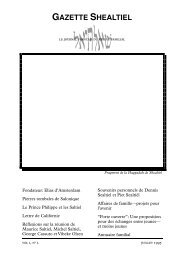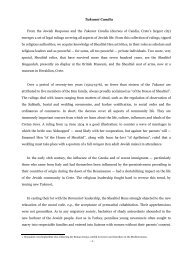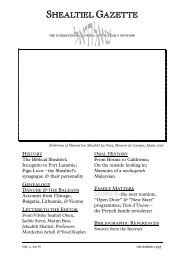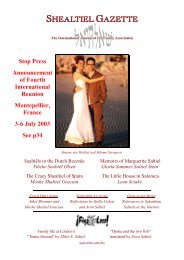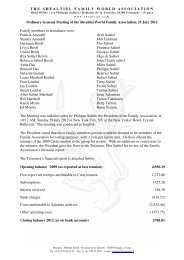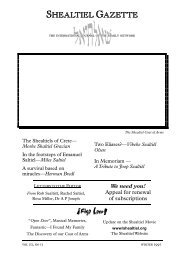a thesis by Flora Jane Satt - Shealtiel
a thesis by Flora Jane Satt - Shealtiel
a thesis by Flora Jane Satt - Shealtiel
Create successful ePaper yourself
Turn your PDF publications into a flip-book with our unique Google optimized e-Paper software.
<strong>Flora</strong> <strong>Jane</strong> <strong>Satt</strong>—annotated <strong>by</strong> Miles SaltielAfter allowing for the exaggeration of children (recognised with the caveat of “approximately”), the cabins described <strong>by</strong><strong>Satt</strong>’s sources satisfy the requirements for homesteading, which would be familiar to the workmen on the spot as thefirst objective of pioneers. The Cotopaxi colonists evidently found them disappointing so they came to serve—if at all—as preliminary lodgings for farmers on remote plots until the more spacious arrangements described <strong>by</strong> Schwarz becameavailable. Such a second round of construction would have been abandoned after the cash ran out. <strong>Satt</strong> also mentionsthat “The men themselves built mud chimneys…” (<strong>Satt</strong>, p21). We should bear in mind that frontier chimneys wereinvariably a labour-intensive affair of stones or mud; given the local labour shortage, these would have been impossibleto build prior to the arrival of the colonists.Costs <strong>Satt</strong> dwells on the imperfections of the accommodation so as to establish one of the pillars of her case againstSaltiel, that he wilfully withheld money from the colonists after overcharging HEAS. When look at the specifics of thecase of overcharging, however, we find that it relies upon a misconstruction. <strong>Satt</strong> argues that “Saltiel…tendered [a bill]to cover the cost of building twenty fine homes at $280.00 each” (<strong>Satt</strong>, p25). This is sourced to Saltiel’s letter to Heilprin,dated 19 September 188o. (<strong>Satt</strong>, III, n18). Earlier, however, she makes it clear that this letter contained Saltiel’soriginal offer (<strong>Satt</strong>, p14; II, n27), so the figures represented a proposal rather than an invoice. <strong>Satt</strong> follows Kohn andWirkowski in pricing the cabins at $100 each. She associates this with information (possibly advertisements) in theRocky Mountain News of 2 December 1880 that ‘Two saw-mills were in operation in the immediate vicinity at this time[with] ‘first-class lumber sold for $22.50 per thousand’ ” <strong>Satt</strong>, p25; III, n19). She declines the final step of working upthe price of the lumber for a log cabin from this and we are unable to do so. In the event Schwarz claimed not for twentybut twelve homes at $280 (Schwarz p15).In this instance, we see that <strong>Satt</strong> failed to take account of the realities of frontier life, that is the pattern of building fallingout of the legal requirements to qualify for homesteading; that she was unaware of any second round of construction;and that she mistook the character of primary correspondence.The late autumn crisisWe confirm the weakness of <strong>Satt</strong>’s sources and approach when we turn to the alternative sequences provided for theevents leading to the late Autumn crisis. Schwarz’ sequence is:Before Schwarz’ report to HEAS (i.e., reported in it)Settlers work in a mine, presumably Saltiel’s, and on the Denver and Rio Grande Railroad,either to pay for the supplies of kosher meat or generally to support themselves.On or around 23 October 1882Schwarz presents his report to the Committee of HEAS in New York.After Schwarz’ report to HEAS (i.e., unreported in it)Potato crop fails and credit stopped.<strong>Satt</strong>’s sequence is:Potato crop fails and credit stopped.Settlers obliged to work in Saltiel’s mine.Settlers discover alternative work at the Denver and Rio Grande Railroad, work there instead.Neither source is wholly satisfactory. The very date of Schwarz’ report is uncertain. It is prefaced, “New York, October23, 1882”. The location is consistent with Schwarz’ remark about parting from the colonists (p16) and tells us that eitherhe presented it personally or was to hand to answer questions. The dating is complicated <strong>by</strong> a comment in his appealfor funds, where he states that Tobias provided assistance between 2 and 18 November. This is at odds with evidenceinternal to his report: at the time he wrote he was still hoping for a successful potato crop (Schwarz, p11), so hemust have written before the “exceptionally early frost [in] the autumn of 1882” which ruined the crop (<strong>Satt</strong>, p24). Thereport’s positive content and tone make it clear that it was written before the crisis which occurred after store credit wasstopped in the late Autumn. Perhaps we can square this circle <strong>by</strong> noting that the document in my possession is aprinted edition of what must originally have been a manuscript. The layout of the document suggests that the table containingthe reference to “November” may have been compressed. On balance, this smacks of another typo.<strong>Satt</strong>’s account is also defective. Her primary sources turn out to be few in number and less than safe. For the account ofthe colonists’ arrival in Cotopaxi, she relies on interviews with elderly informants, long after the events concerned tookplace. Ornstein has already been shown to be unreliable and the safety of material sourced from Quiat and Singer ischallenged above.43



